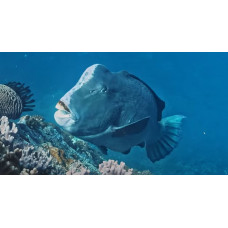Latin name
Bolbometopon muricatum
Other names
Bumphead parrotfish, humphead parrotfish, double-headed parrotfish, buffalo parrotfish, giant parrotfish.
Identification
They have an upright head profile, evenly covered with scales except at the front of the head. The adult develops a convex forehead, exposing the dental plates, which are only partially covered by the lips. Distinguished by the following features: median anteroposterior scales 2-4 (may be covered by a hump); 3 rows of cheek scales, 1 (4-6), 2 (3-6), 3 (1-2); pectoral fin rays 16 or 17; distinctly steep profile; unique nodules on the teeth; conspicuous bump on the adult forehead (visible for at least 25 cm in length); body depth 2.0-2.5 inches wide, increasing in depth with growth.
Features of fish fins
Dorsal spines: 9; Dorsal soft rays: 10; Anal spines: 3; anal soft rays: 9.
Fish colouring
Females and males are equally coloured. The colouration is initially dull grey with scattered white patches, gradually becoming uniformly dark green. The front of the head is often light green to pink.
Distribution
Inhabits the waters of the Indian and Pacific Oceans, from the Red Sea in the west to the Samoa Islands in the east of its range, and from Yaeyama (Japan) and Wake (an atoll between the Philippines and Hawaii) in the north to the Great Barrier Reef (Australia) and New Caledonia in the south: between 30°N and 24°S.
Habitat
Occurs at depths of 1 to 30 metres. Juveniles are found in lagoons, while adults inhabit the clear outer lagoon and reefs facing the sea.
Size
The largest member of the family, reaching 1.3m in length and up to 46kg in weight. This species is slow growing.
Behavior
A gregarious species. Occurs in schools of up to 40 individuals. Sleeps at night between corals, in caves and shipwrecks.
Males may bump their thick foreheads during fights.
Food and feeding habits
The largest herbivorous fish living on coral reefs. They feed on corals, algae and molluscs.
Reproduction
Egg-laying, pronounced mating during reproduction. Fish spawn near the outer slope of the reef, headlands, gullies and estuaries during the lunar cycle, usually just before the new moon. They can live up to 40 years.
Fishing
This species is highly sought after by fishermen throughout its range and is vulnerable to overfishing.
Relationship with a person
Harmless to humans. Used in aquariums.
| Classification | |
| Phylum | Chordata |
| Class | Actinopterygii |
| Squad | Labriformes |
| Family | Scaridae |
| Genus | Bolbometopon |
| Species | B. muricatum |
| Features | |
| Conservation status | Vulnerable |
| Habitat | Littoral |
| Life span, years | 40 |
| Maximum body weight, kg | 46 |
| Maximum length, cm | 130 |
| Sailing speed, m/s | No information |
| Threat to people | Edible |
| Way of eating | Bentophage |



